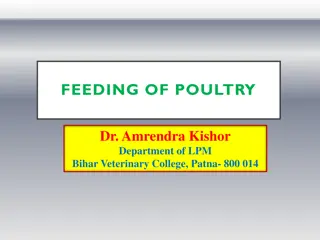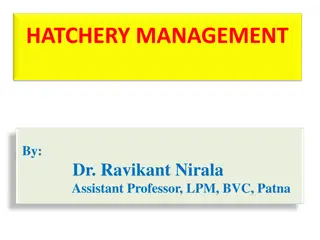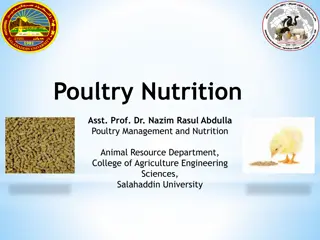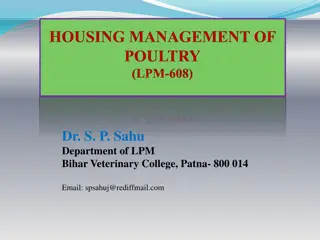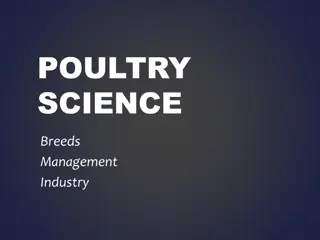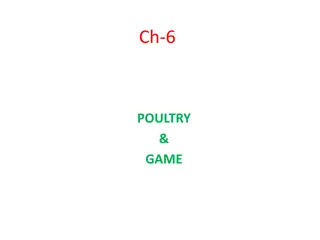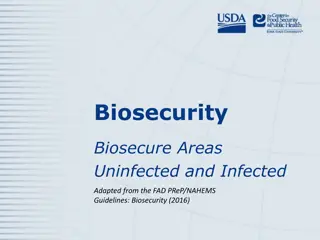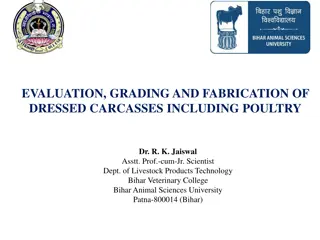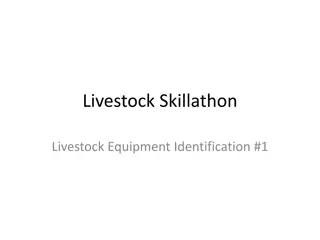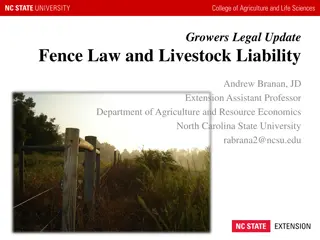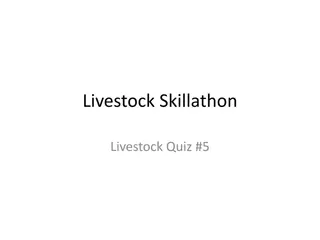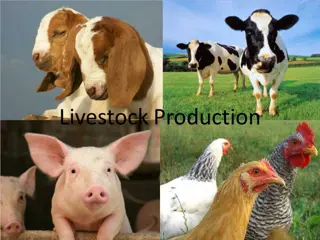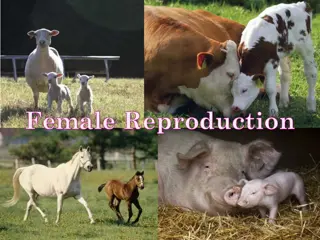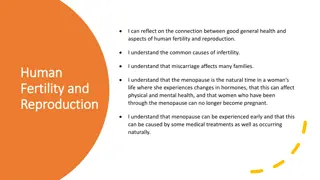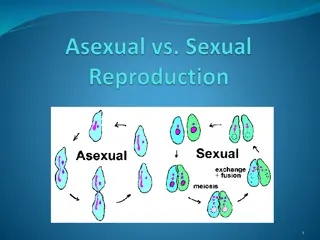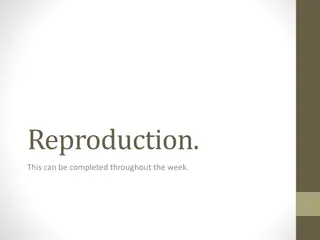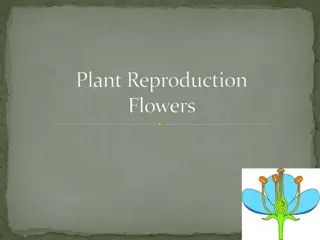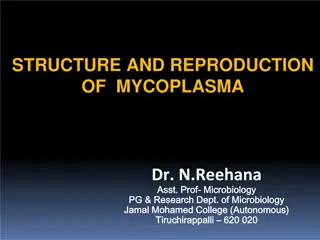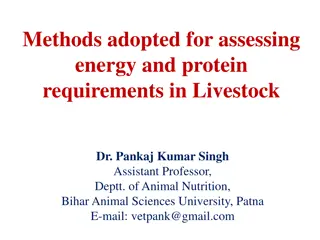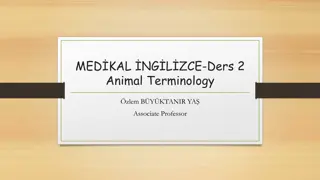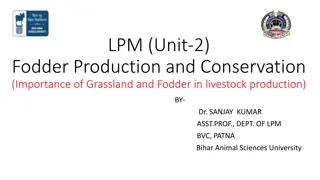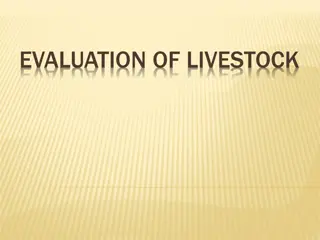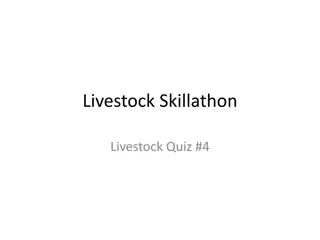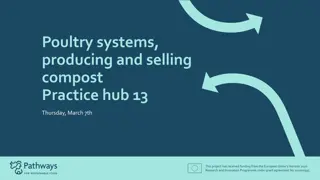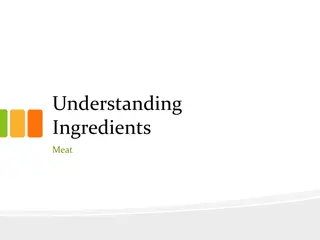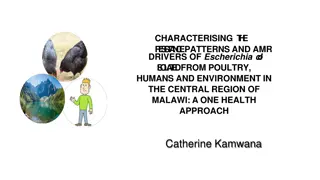Understanding Reproduction in Livestock and Poultry Management
This course delves into the intricate processes of reproduction in farm animals and poultry, covering stages like proestrus, estrus, metestrus, diestrus, and anestrus. It explores the roles of hormones like testosterone, estrogen, progesterone, relaxin, and oxytocin in regulating reproductive functions. Detailed insights are provided into the male and female reproductive systems, from testicles and ovaries to the vas deferens and oviducts. Emphasis is placed on key concepts such as sperm production, ovulation, and embryonic development, offering a comprehensive understanding of this essential aspect of livestock and poultry management.
Download Presentation

Please find below an Image/Link to download the presentation.
The content on the website is provided AS IS for your information and personal use only. It may not be sold, licensed, or shared on other websites without obtaining consent from the author. Download presentation by click this link. If you encounter any issues during the download, it is possible that the publisher has removed the file from their server.
E N D
Presentation Transcript
Livestock & Poultry Management ASAP2101(2-1-0) Session: 2 Reproduction in farm animals and poultry
Consists of proestrus, estrus, metestrus, diestrus and anestrus 1. proestrus- begins after corpus luteum regression, ends at the onset of estrus. During this period there is rapid development of the follicle which leads to ovulation and the onset of sexual receptivity 2.estrus- time of sexual receptivity, may be referred to as heat. Ovulation usually, but not always, occurs at the end of estrus. Some species, like cats and ferrets, are induced ovulators 3.metestrus- the early postovulatory period during which the corpus luteum begins development
4. diestrus- the period of mature luteal activity which begins about 4 days after ovulation end ends with regression of the corpus lutem. 5. Anestrus- without estrus cycles
Hormones Male Testosterone- critical for sperm development Female Estrogen- critical for follicle development Progesterone- sustains pregnancy and inhibits new follicle development Relaxin- causes ligaments around birth canal to relax Oxytocin- causes milk letdown
Male Reproductive System Testicles- Site of sperm production and testosterone synthesis Sperm contain of genetic makeup Epididymis- Sperm storage andmaturation Scrotum- Protects testes and regulates temperature http://biotech-adventure.okstate.edu/low/basics/reprod/animal/male/diagram/
Male Reproductive System Vas Deferans- Transports sperm from epididymis to urethra Urethra- tube inside of penis transports sperm or urine exterior Penis- organ of copulation http://biotech-adventure.okstate.edu/low/basics/reprod/animal/male/diagram/
Female Reproductive System Ovaries- Produce egg Egg contains of genetic makeup Oviducts- Site of fertilization Transport embryos to uterus Uterus- Site of embryonic development during gestation
Female Reproductive System Cervix- Connects uterus and vagina Serve as barrier during pregnancy Vagina- Female organ of copulation at mating Opening of bladder Vulva- External opening of reproductive system
Different Female Reproductive Systems http://www.ansi.okstate.edu/course/3443/study/Notes/female/tracts.htm
Events of Reproduction Puberty- Age at which reproductive organs become functional Female- Reproduction process occurs within Estrous cycle- Repetitive cycle occurring when pregnancy does not Estrus- Heat or receptivity to mating Fertilization- Egg & Sperm unite Only real male contribution is the sperm Gestation- Length of time of pregnancy Parturition- Act of giving birth
Age of Puberty 6 to 12 Months 5 to 7 Months 4 to 12 months 4 to 8 Months 12 to 15 Months 9 to 16 YEARS Cattle: Sheep: Goat Swine: Horses: Humans:
Estrous Cycle Cattle: Polyestrous (cycle throughout year) Sheep and goat: Seasonal (Decreasing light, Fall) Swine: Polyestrous (cycle throughout year) Horses: Seasonal (Increasing daylight, Spring)
Length of Estrus Cycle Cattle: Sheep and Goat: Swine: Horses: 19 to 23 Days 14 to 19 Days 19 to 23 Days 10 to 37 Days
Duration of Estrus Cycle Cattle: Sheep and Goat: Swine: Horses: 6 to 27 Hours 24 to 36 Hours 48 to 72 Hours 3 to 8 Days
Signs of Estrus Swollen vulva Mucous discharge Restless behavior Female receptivity to male http://www.goodecattle.com/spot.htm
Specific Signs of Estrus Cattle: Visually active mounting Sheep and Goat: Few external signs Swine: Brace with pressure to back, vocal grunting Horses: Tease with Stallion and will go nose to nose
Gestation Length Cattle: Sheep and goat: Swine: Horses: 285 Days 147 Days 114 Days 336 Days
Partition Names in Species Cattle: Sheep and goat: Swine: Horses: Calving Lambing Farrowing Foaling
Signs of Parturition Distended abdomen Mammary development & milk secretion Swollen vulva and relaxed pelvic ligaments Mucous discharge Relentlessness and separation from group Labor and Contractions
Signs of Parturition Appearance of placental membrane Expulsion of fetus Expulsion of placental membrane Bonding behavior of offspring and mother (will vary between species) http://www.ansc.purdue.edu/dairy/4-H/amdairy.htm
Factors affecting risk of dystocia Abnormal presentation Multiple births Heifer vs cow Pelvic measurement Nutritional status- obesity/malnutrition - - - - -
Repulsion then traction Pubic symphysiotomy- in first calf heifers, if calfs head is larger than the pelvic canal the veterinarian can open and spread the suture between the pubic bones thus enlarging the pelvic canal diameter Cesarean section Fetotomy- if fetus is dead, dismembered and delivered in pieces. Note: care must be taken to avoid sharp bone pieces piercing/rupturing uterine wall
Vaginal/uterine prolapse Obturator paralysis Milk fever/hypocalcemic tetany Rejection of offspring
Male Transfer of Sperm Two different ways Let the male and female naturally engage. Male seeks out female in Estrus All controlled by male and female interaction Artificial Insemination (AI) Human transfers semen past female cervix Human is in control of male product and female interaction No contact between male and female
Artificial Insemination (AI) Pros Conception rate is high Extends use of superior males One ejaculate can fertilize many females Reduce incidence of venereal diseases Individual straw per female Improves record keeping and mgt. Know exactly who the father is Can accelerate genetic improvements
Artificial Insemination (AI) Cons Need to know Estrus Cycle of animal Cost intensive Pay for someone to AI animals
AI Use in FarmAnimals Dairy Cattle: widely used Beef Cattle: limited use (herds hard to monitor) Sheep: limited use (need to use microscope) Swine: intermediate use Horses: restricted by breed associations
Basic AI Process Check for Heat Have all necessary tools Make sure tools are clean Clean her exterior surface Go through the AI process for the species being bred Assessment, record important information (date, time, who to etc) www.ces.purdue.edu/ pork/clipart/reprod.htm
How Animals Differ Cattle: Follow cervix through anus, guiding the pipette Sheep: Use microscope to guide pipette Swine: Out of body guiding of pipette Horses: Restricted by breed
Swine AI Process Check for Heat Use a teaser bore for receptivity Listen to see if vocal Swollen vulva with secretion Apply back pressure Tight arms Ears flapping www.ces.purdue.edu/ pork/clipart/reprod.htm
Swine AI Process Have all necessary tools Catheter/pipette Lube Semen Baby wipes Make sure tools are clean http://www.ansc.purdue.edu/swine/porkpage/repro/sow2.htm
Swine AI Process Put pressure on back to stimulate mounting Lubricate catheter Insert catheter at a 30- 45 degree angle following vulva Push in about 4-6 inches http://www.ansc.purdue.edu/swine/porkpage/repro/mngt3.htm
Swine AI Process Move catheter to horizontal position and gently move forward until resistance is felt Rotate counterclockwise once you have hit resistance Feel for pressure from cervix (see if holds pipette) Will pulsate up and down http://www.ansc.purdue.edu/swine/porkpage/repro/mngt3.htm
Swine AI Process Connect semen onto catheter Give small squeeze to initiate flow of semen Should suck in herself DO NOT RUSH After semen is gone give a five count Rotate catheter clockwise and gently pull out http://www.ansc.purdue.edu/swine/porkpage/repro/mngt3.htm
Assessment AI Process Make sure semen took by checking that it didn t leak out or urinated out. Record important information Date Time Who to Anything else that you feel is crucial
Colostrum -Requirement 1 liter per 100 lbs -Colostrum banking- dams will produce more colostrum than needed. After neonate has consumed a sufficient amount, the rest may be milked out and frozen for storage for up to 1 year
Colostrum quality- (quality = immunoglobulin content) - subjective- stickiness, thickness (Note: color is not a reliable criteria for assessing quality) Objective- specific gravity > 1.060 - Gut closure- the neonatal intestinal tract has the transient capability to absorb large ( immunoglobulins) molecules intact. That capability is lost after 24 hours or the consumption of 32 ounces of material. Colostrum consumed after gut closure is of no benefit. a. b. behavior- strong suck reflex Umbilicus- iodine ( foals apply every 12 hours until navel remains dry) Meconium- feces that accumulates in the colon during fetal development, can be rock hard and difficult to pass. If straining is observed, administer phosphate enemas until meconium is passed. ( colostrum has laxative) - - -
What the major male and female reproductive organs in poultry and their functions? III. The reproductive systems of poultry are similar to that found in mammals with a few differences. The reproductive system of the male poultry includes the testicles, which are held within the body cavity rather than in a scrotum. The testicles produce the sperm and seminal fluid.
Male Poultry Reproductive System 1.The vas deferens carries the seminal fluid and sperm cells to the cloaca. 2.The cloaca is the enlarged part where the large intestine joins the end of the alimentary canal. 3.The alimentary canal is the food- carrying passage that begins at the mouth and ends at the vent. 4.The papilla is the organ in the wall of the cloaca that puts the sperm cells into the hen s reproductive tract.
Female Poultry Reproductive system The reporductive system of female poultry has two ovaries and two oviducts. The right ovary and oviduct do not function. Only the left ovary and oviduct produce eggs. The ova produced in the ovary develop into egg yolks. The oviduct of the chicken has five parts:
Five Parts of Oviduct 1.Funnel - receives the yolk from the ovary. The sperm cells that the chicken receives from the male are stored here. 2.Magnum - secretes the thick white of the egg. It takes approximately three hours for the thick white to be placed around the yolk in the magnum. 3. Isthmus - The yolk and thick white move from the magnum into the isthmus, where two shell membranes are placed around the yolk and thick white. This process takes approximately 1 hours.
4. Uterus- The developing egg remains in the uterus for 18-20 hours while approximately 40% of the albumen and all of the shell is added. It is for this reason that the organ is often called the shell gland 5. Vagina - From the uterus, the egg moves into the vagina. The egg stays here only a short time after which it is laid. It takes about 25 to 27 hours for a chicken to produce one egg
What are the phases of reproductive development in the life of an animal? Incubation is the development of a new animal in the fertile egg of poultry, fish, and other egg-laying species. Spawning is the releasing of eggs by a female fish and fertilization by the male. the subsequent
What are the phases of reproductive development in the life of an animal? A female may lay thousands of eggs at one spawning. The male fish then fertilizes the eggs by releasing sperm on the mass of eggs.
Four Factors in Incubating Eggs 1.Temperature should be maintained at 99 to 103 F. 2.Humidity should be about 60 % during the first 18 days and 70 % during the last 3 days. 3.Oxygen - Sufficient air exchange to prevent carbon dioxide buildup. 4.Egg rotation - Eggs should be rotated two to five times daily for the first 18 days.


